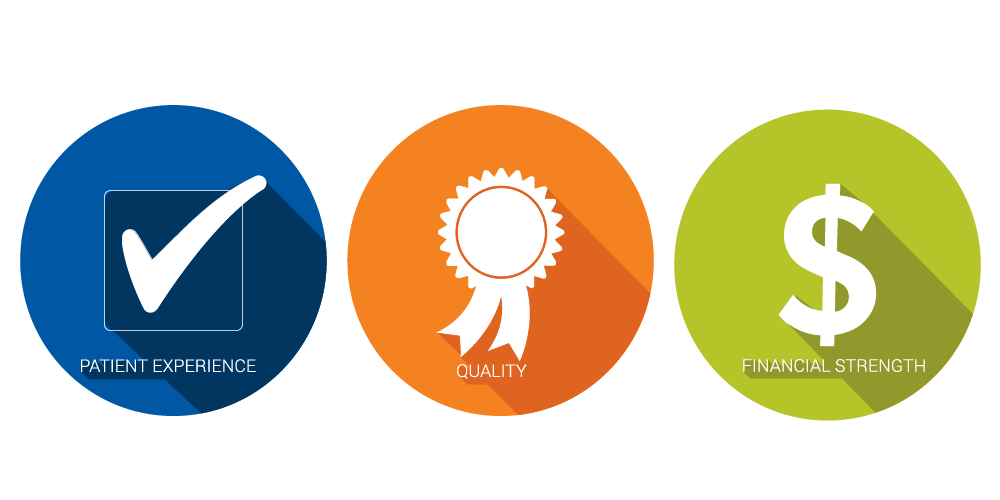losing the strategy-to-execution gap is a classic problem that many organizations never solve. Often strategy and execution operate in different sectors, with strategy operating at the highest levels of the organization and the operational leaders consumed by day-to-day functions. We have invested in bringing both strategy and execution together with a disciplined planning process.
Translating strategic priorities into everyday execution across a large, complex enterprise might seem daunting, but it doesn’t have to be. Our Operational Plan is a blueprint that combines process, tools, knowledge, and skills to deliver on these priorities. The Operational Plan involves commitment of individual knowledge, skills, and talents woven together with large-scale infrastructure, operations, and technology. The result is progress that few other enterprises can match.
What is the Operational Plan?
The operational plan is developed annually and includes 45 key initiatives that fall under three goals: Exceptional Patient Experience, Quality, and Financial Strength (See FY17 example).
How we create it
The 12-month annual planning cycle begins in Q1, under the direction of Dr. Vivian Lee, Senior Vice President for Health Sciences. The organization updates the system strategic plan and establishes the institutional goals, spanning all three missions—academics, research, and clinical care.
With direction of the institutional goals, University of Utah Hospitals and Clinics (UUHC) and University of Utah Medical Group (UUMG) leadership teams meet to identify initiatives needed in the next fiscal year. These initiatives all fall under the goals of Exceptional Patient Experience, Quality, or Financial Strength. A consolidated list of proposed initiatives is sent out via an online poll to over 120 leaders from across the organization. The list is then narrowed down into 45 prioritized initiatives.
Operational plan timeline

(Quarters follow the fiscal year, beginning July 1 - ending June 30.)
Using the prioritized list, leaders meet for an annual Operational Plan retreat to further discuss, review, and approve the proposed initiatives in each area. The result is focus. Each goal now has 3 to 5 initiatives that will have impact on the future.
Once the initiatives are approved, a smaller working group of members from the hospital (Operations Council and service line directors) and the medical group (UUMG leadership and School of Medicine department administrators) work to develop metrics for each initiative. The hospital CEO and COO as well as the Medical Group president provide final approval for the operational plan.
During Q3, the Operational Plan informs capital and operational budgeting decisions. This step ensures financial resources to accomplish the efforts, and helps individuals as they prioritize their work throughout the year.
In Q4, hospital employees receive their annual performance evaluation. This is an important step to align the entire organization. Hundreds of leaders review thousands of employees’ accomplishments during the previous year, and discuss each worker’s impact on the organization. This review is also a time when next year’s individual performance goals are discussed.
With the planning complete, the fiscal year begins. Executive sponsors from UUMG and UUHC are identified for each initiative. Sponsors and teams meet regularly throughout the year to accomplish the tasks. The Decision Support department tracks quarterly performance on an Operational Plan dashboard. Departments document their efforts in Value Summaries, and individual contributions are documented in performance reviews.
The year closes out with publication of the Exceptional Value Annual Report. This report documents the performance of the organization on all 45 of the key initiatives identified in the Operational Plan. Successes are celebrated and nonconformities are reviewed for learning.
Reflection
Strategy works best when it is attainable. We have made deliberate effort to increase all our leaders’ competency to understand AND execute strategy. We have changed strategy from a once-every-five-years discussion to something that is central to daily work. We continuously focus on the capabilities we need to develop, the financial investment we have to make, and the changes we need to succeed. The result is an organization with a clear context for change, connection between strategy and daily work, and the ability to harness the innovation that is at the core of every team.
Chrissy Daniels
Why do some organizations thrive during a crisis while others flounder? Iona Thraen, director of patient safety, joined forces with her ARUP Laboratory colleagues to learn how the world-renowned national reference lab adapted to the pandemic. Leaders created a culture of safety by putting innovation, learning, and patient-centered care at the heart of all their efforts.
Chronic conditions do not pause during a pandemic. When faced with delaying the care of over 1,000 patients with neurological conditions, Susan Baggaley, Neurology Vice Chair and Ambulatory Chief Value Officer, and Vivek Reddy, Neurology Vice Chair and Inpatient Chief Value Officer, rapidly developed a new virtual visit workflow.
Magnet Program Director Mary-Jean (Gigi) Austria explains how Nursing Shared Governance provides support for knowledge sharing, clinical skill building, and collaborative decision-making closest to the point of care.
